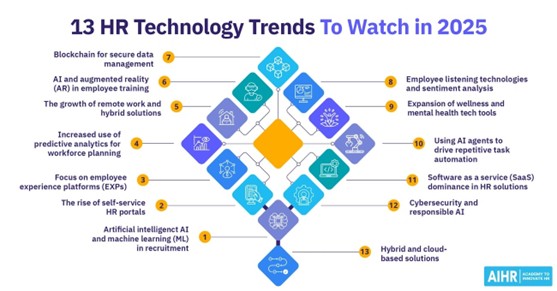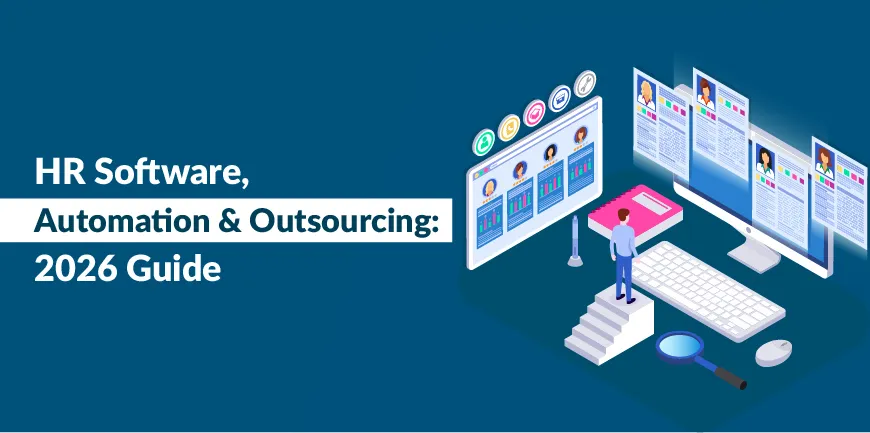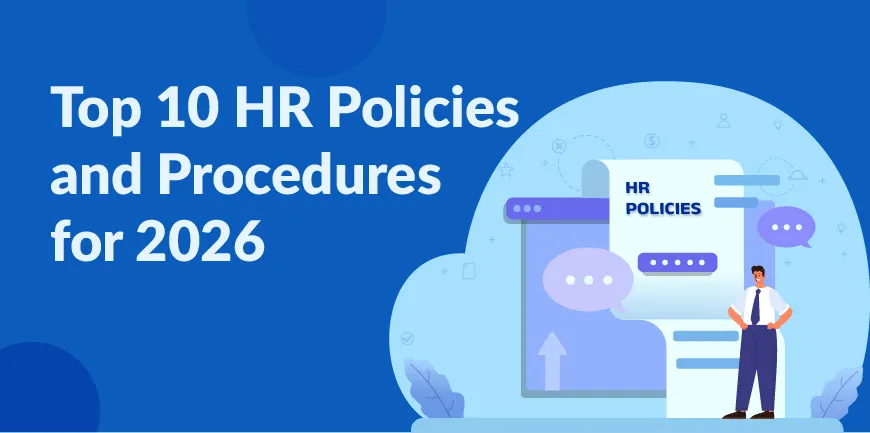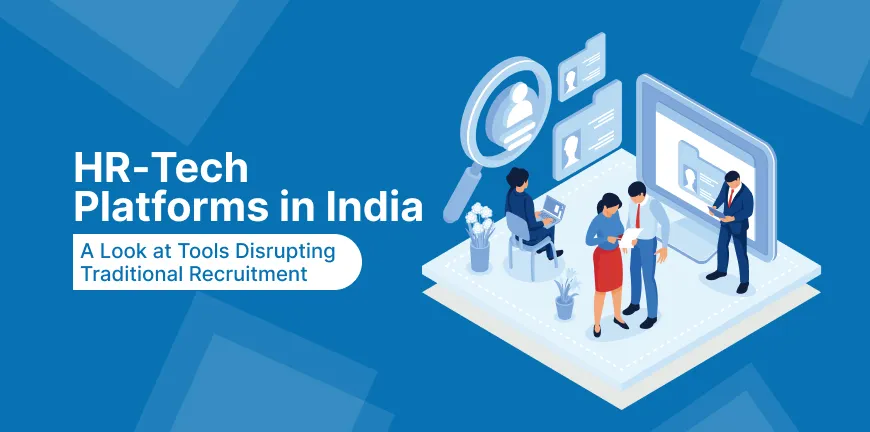
EVP in Healthcare: Attracting and Retaining Critical Talent
07/09/2025
Understanding Generation Z Employees in the Workplace
12/09/2025Today, the human resources landscape is revolutionizing, and it is not just about people management anymore. It is about driving plans and blueprints through data. In this modern arena, HR teams are expected to work using quantifiable derivatives instead of relying on intuition. This will enable them to make intelligent decisions directly impacting company performance.
According to Deloitte’s 2024 Global Human Capital Trends research, 81% of business executives surveyed acknowledged that their business and people agendas are more intertwined than ever before.
This growing connection between organizational success and workforce management explains why HR teams must embrace data-driven approaches. Organizations currently face significant challenges, including lengthy hiring processes, a persistent gender pay gap where women earn less than men. The cost of replacing an employee can reach up to 1.5-2x their annual salary, particularly for senior roles.
The benefits of adopting key HR metrics and analytics are substantial. As per research, companies effectively utilizing people analytics experience a 25% increase in business productivity, while 82% of executives agree that HR metrics are valuable for their organization.
During the pandemic, over 80% of business leaders reported they could not operate effectively without HR technology, including data analytics.
Are you prepared to transform your HR department from a cost center into a strategic business partner?
This guide explores the 29 essential HR metrics examples that every data-driven HR team should track in 2025.
What Are HR Metrics?
HR metrics, or human resource metrics, are quantitative measurements allowing organizations to assess the efficiency and effectiveness of their HR functions. These metrics represent specific data points that track various workforce activities, including employee performance, retention, compensation, engagement, and recruitment processes.
Before diving into the complexities of analytics, let us understand what makes HR metrics different from standard business measurements. Unlike general business metrics, HR metrics are focused on an organization’s most valuable asset, its people. These measurements enable HR professionals to quantify the impact of HR initiatives, evaluate program success, and connect people’s data with business outcomes.
The scope of human resources metrics extends across numerous areas within the HR function. These typically entail turnover rates, training effectiveness, return on human capital, labor costs, and expenses per employee. Companies can identify year-over-year trends and monitor changes in these critical variables through systematic tracking, gaining insights into their workforce dynamics.
Here is what makes HR metrics particularly powerful: they transform subjective assessments into objective evaluations.
Over 80% of business leaders acknowledged they could not have operated effectively during the pandemic without HR technology, including data analytics. This highlights how integral these metrics have become to modern organizational management.
HR metrics fall into several categories based on the aspects of human resource management they measure:
- Recruitment metrics: Time-to-fill, cost-per-hire, quality of hire
- Performance metrics: Employee productivity, goal achievement
- Retention metrics: Turnover rate, retention rate
- Training metrics: Training effectiveness, skills development
- Compensation metrics: Salary competitiveness, pay equity
These categories help organizations focus their analysis on specific areas of HR management that require attention or improvement.
HR metrics serve a dual purpose: internal tracking and external benchmarking. Internally, organizations monitor these metrics over time to measure progress and establish improvement goals.
Externally, companies compare their HR metrics against industry standards to assess competitiveness and identify best practices worth adopting. This dual perspective enables organizations to remain agile in a constantly evolving business landscape.
The strategic value becomes clear when you consider this shift: HR teams can now show how their practices positively affect human capital and contribute to organizational success. Rather than merely assessing departmental efficiency, this approach has elevated the HR function from an administrative role to a strategic partnership with senior management.
HR metrics have evolved from being advantageous to essential components of data-driven management strategies. According to research, 87% of respondents indicated that HR reporting metrics directly influence their organization’s strategy. This statistic highlights the growing recognition that workforce analytics represent a crucial puzzle piece in strategic decision-making.
Organizations track HR metrics primarily to understand effectively, identify improvement areas, and potentially predict future trends. These data points help companies answer critical questions such as why employees resign, how much employee replacement costs, whether compensation practices are equitable, and whether employees face burnout risks.
The workplace continues to evolve at an unprecedented pace, from the rapid shift to hybrid work models to incorporating emerging technologies like generative AI. Tracking essential HR metrics helps organizations navigate these changes while maintaining focus on their strategic objectives.
For HR seeking to become more data-driven, understanding these metrics becomes the first step toward implementing people analytics. With people being one of the most valuable and expensive assets any business possesses, tracking HR metrics provides invaluable insights into which strategies work effectively and which require modification.
Why HR Metrics Matter in 2025?
Labor costs continue escalating at unprecedented rates, accounting for 70% of private industry employer costs in March 2025. The Nonfarm businesses report states that labor costs increased by 6.6% in the first quarter of 2025 alone. These mounting expenses force organizations to scrutinize every aspect of workforce management with accuracy.
The business case for HR metrics in 2025 is undeniable. For every dollar invested in workforce planning metrics, organizations see returns of INR 1097.79. Companies still operating on intuition rather than data face dangerous competitive disadvantages as the corporate landscape evolves rapidly.
HR departments must transform from administrative functions into strategic partners that directly contribute to organizational goals and financial health. This transformation requires robust measurement systems that demonstrate tangible value to leadership teams.
HR metrics serve multiple critical functions in today’s organizations:
1. Strategic talent management
HR metrics help identify talent needs and gaps, guiding strategic decisions in talent acquisition, development, and retention. This becomes especially valuable as 58% of HR executives identify shifting skill demands as their primary challenge.
2. Cost optimization
Through analyzing recruitment, training, and turnover costs, HR metrics enable efficient budget allocation and reveal cost-saving opportunities. Given that HR represents one of a business’s greatest overhead expenses, this optimization directly impacts the bottom line.
3. Evidence-based decision making
HR metrics eliminate reliance on intuition, providing hard data that validates choices and helps leaders make objective, strategic decisions aligned with business goals.
A PwC survey found that organizations heavily relying on data are three times more likely to see substantial improvements in business decision-making.
4. Early problem identification
Metrics help organizations spot potential issues before they escalate, allowing for timely intervention. This proactive approach is particularly valuable when managing employee engagement in remote or hybrid work environments, where regular in-person interaction is limited.
The gap between organizations using HR metrics and those falling behind continues widening. Currently, 71% of HR executives using people analytics consider it essential to their organization’s HR strategy. However, merely 32% of companies actively use workforce planning & analytics, revealing a significant opportunity for competitive advantage.
The World Economic Forum projects that within five years, nearly half of current employee competencies will become irrelevant. Simultaneously, 81% of organizations acknowledge acute shortages in key technical capabilities. HR metrics serve as essential tools for forecasting, planning, and optimizing the workforce for future needs.
Looking forward, 80% of firms will incorporate AI into HR operations by late 2025. Organizations embracing predictive modeling see substantial benefits, including a 50% reduction in attrition rates. The shift toward data-driven HR reflects fundamental changes in how businesses operate, from managing hybrid work models to incorporating emerging technologies.
Companies embracing HR metrics and analytics will identify opportunities earlier, allocate resources more effectively, and build workforces better aligned with strategic objectives. HR metrics is the new language in high-profile board meetings, an essential component of organizational success that no forward-thinking company can afford to ignore.
29 HR Metrics Every HR Professional Must Track in 2025
Data-driven HR teams require systematic measurement tools to track workforce dynamics, optimize processes, and align manpower resources with business objectives. These essential human resources metrics enable HR professionals to translate people data into actionable strategies that directly impact organizational success.
The following 29 metrics serve as a complete framework for measuring every aspect of your workforce management strategy:
Recruitment Metrics
Tracking recruitment effectiveness reveals how well your organization attracts and secures talent:
- Time-to-Fill: The average number of days between job requisition approval and offer acceptance. The industry average hovers around 44 days.
- Time-to-Hire: Measures days from when a candidate enters your pipeline until acceptance, highlighting recruitment efficiency.
- Cost-per-Hire: Combines internal and external recruiting expenses divided by the number of hires, justifying recruitment budgets.
- Quality-of-Hire: Considered one of the most important elements of HR metrics by 88% of recruiting professionals, this composite metric assesses new hire value through performance, retention, and manager satisfaction.
- Offer Acceptance Rate: Tracks percentage of job offers accepted, helping evaluate compensation competitiveness and recruitment effectiveness.
Retention and Turnover Metrics
Understanding why employees stay or leave provides crucial workforce stability insights:
- Employee Turnover Rate: The percentage of employees leaving over a specific period, calculated by dividing departures by average headcount.
- Voluntary vs. Involuntary Turnover: Distinguishes between employee-initiated and company-initiated departures.
- Early Turnover: Percentage of new hires leaving within their first year, indicating onboarding or hiring mismatches.
- Retention Rate: The inverse of turnover, showing the percentage of employees who remain.
- Time Since Last Promotion: Useful in explaining why high-potential employees leave.
Employee Engagement Metrics
Engaged employees drive productivity & innovation:
- Employee Net Promoter Score (eNPS): Measures employee willingness to recommend their workplace, with scores between 10-20 considered reasonable, 20-30 good, and 40-50 outstanding.
- Employee Satisfaction Index: Aggregates survey responses about job satisfaction.
- Career Path Ratio: Divides promotions by all role changes (upward and lateral), tracking internal career development.
- Absenteeism Rate: Calculated by dividing unexcused absences by total workdays and multiplying by 100.
- Presenteeism Rate: Measures employees physically present but mentally disengaged, costing companies an estimated INR 12657.07 billion in lost productivity.
Performance Metrics
Quantifying employee contributions reveals workforce effectiveness:
- Goal Achievement: Measures of how effectively employees meet targets over set periods.
- Work Quality: Examines, accuracy, thoroughness, and standards of output through error rates and stakeholder feedback.
- Productivity Efficiency: Measures output relative to time and resources.
- 360-Degree Feedback: Incorporates perspectives from managers, peers, and direct reports.
- Revenue per Employee: Total revenue divided by employee count, tracking workforce value trends.
Training and Development Metrics
Effective skill development drives future success:
- Training ROI: Calculated as (Return on benefit – Investment cost) / Investment cost × 100.
- Training Effectiveness: Evaluates whether learning objectives were achieved, and skills were successfully applied.
- Skills Development: Tracks employee growth alongside evolving business needs.
- Training Completion Rate: Percentage of employees completing assigned training programs.
Diversity, Equity, and Inclusion Metrics
Diverse workforces foster innovation & business growth:
- Diversity Hiring Rate: Percentage of hires from underrepresented groups.
- Pay Equity Index: Compares compensation across demographic categories to identify potential disparities.
- Representation Metrics: Tracks workforce diversity percentages across gender, racial, and ethnic backgrounds, particularly in leadership roles.
HR Operations Metrics
Efficient HR operations support organizational effectiveness:
- Cost of HR per Employee: Total HR costs divided by employee count, revealing HR department efficiency.
- HR-to-Employee Ratio: Typically, around 1:50 or 2% (2 HR professionals per 100 employees).
These metrics serve as a foundation for data-driven HR management. Organizations must select metrics aligned with their specific business challenges and strategic objectives. For maximum impact, establish baselines, set improvement targets, and regularly review metrics to identify trends and opportunities for workforce optimization. With these essential human resources metrics, HR professionals can elevate their strategic contribution while effectively managing their workforce.
Best Practices for Tracking HR Metrics in 2025
Now that you have identified the right metrics for your organization, how do you ensure your HR analytics program delivers meaningful results rather than just generating reports?
The successful implementation of human resources metrics requires a methodical approach that goes beyond simply gathering data. Organizations that implement effective HR metrics follow several proven practices to maximize impact and drive meaningful results.
Here are the 8 best practices for tracking HR metrics effectively:
1. Start Small and Build Momentum
Focus on 3-5 core metrics consistently before expanding your analytics program. Companies often fall into the trap of trying to measure everything at once, which leads to inconsistent data inputs, fragmented focus, and analysis paralysis that undermines the entire initiative.
2. Standardize Data Collection Processes
One major barrier to useful HR metrics is the inconsistency of different teams tracking information in different ways, making meaningful comparison nearly impossible. Companies must implement identical fields, issue categories, and workflows across all departments, regions, and functions to ensure data comparability. This standardization becomes considerably easier when using centralized HR platforms with structured templates and pre-configured workflows.
3. Create Compelling Data Visualizations
Dashboards make trends straightforward to identify and effortlessly share with stakeholders. The global people analytics market, valued at INR 254.83 billion in 2023, is projected to reach INR 757.74 billion by 2032, primarily driven by HR’s need for critical insights when making decisions.
4. Transform Data into Actionable Insights
As the Society of Human Resource Management (SHRM) emphasizes, “It is the insight that produces value, not the metric itself”. Companies must analyze data thoroughly to draw meaningful conclusions instead of merely collecting numbers. Transform raw metrics into compelling narratives by connecting them to tangible business outcomes using trend analysis to identify attrition risks or examining patterns to improve manager effectiveness.
5. Embed Analytics into Daily Operations
You must not wait for trends to surface after problems occur; try integrating metrics into every case, report, and decision from the start. This proactive approach helps identify risks early, enabling faster action & more strategic leadership decisions.
6. Maintain Data Quality & Privacy Standards
The quality of insights depends heavily on the accuracy of data inputs. Companies must establish data governance protocols, train HR staff on proper validation techniques, and schedule regular audits to identify anomalies. Organizations must ensure strict data maintenance privacy standards, especially with sensitive employee information. Limit access to authorized personnel, encrypt confidential information, and communicate privacy policies transparently.
7. Segment Data for Deeper Understanding
Data segmentation prevents misleading conclusions from one-size-fits-all analysis. Examine metrics by variables like department, location, job level, or tenure to gain a more nuanced understanding of workforce patterns. For instance, an overall engagement score of 75% might mask that frontline workers in specific regions score only 52%, highlighting localized leadership issues.
8. Target the Right Audience for Each Metric
Not every team will find all metrics relevant to their responsibilities. Metrics like new-hire turnover and time-to-hire may be more suitable for recruiting teams compared to middle managers.
Organizations must determine their own goals and targets for HR metrics. There is no universal formula for the ideal training cost or perfect turnover rate. Set specific, measurable objectives for each metric that reflect your organization’s unique circumstances, industry benchmarks, and strategic priorities.
Companies adhering to these best practices transform their HR departments from administrative functions into strategic business partners capable of delivering insights that drive organizational performance.
Future Trends in HR Metrics

Image Source: AIHR
Are you prepared for the dynamic shift happening in HR measurement?
The HR landscape of 2025 and beyond is undergoing a profound transformation, with artificial intelligence and predictive technologies reshaping how organizations measure and optimize their workforce. Progressive human resources metrics are becoming indispensable tools for business success.
Only 20% of executives currently report that HR owns the future of work strategy at their organizations. This gap highlights an extraordinary opportunity for HR departments to elevate their strategic influence. Additionally, 57% of CEOs believe culture change outweighs technical challenges during data-driven transformations, emphasizing that successful implementation requires more than sophisticated tools.
AI integration represents the most significant evolution in human resources metrics. By 2025, approximately 80% of firms will incorporate AI into their HR operations. This integration delivers substantial efficiency gains across functions while improving decision-making through data analysis that supports evidence-based choices rather than intuition. AI implementation elevates the HR function from administrative tasks to a strategic business partnership.
What Does the Future of Predictive Analytics Hold?
The future of predictive analytics in HR shows remarkable potential:
- Companies utilizing predictive models have reduced turnover rates by 30%
- Organizations using AI for HR functions report a 40% increase in employee satisfaction
- Teams monitoring hybrid work dynamics through HR analytics observe 15% productivity improvements
Workforce planning transformation emerges as another compelling trend. Currently, merely 15% of companies engage in strategic workforce planning, revealing a substantial opportunity for organizations to align talent with long-term business goals. This shift becomes even more critical considering the global talent shortage is projected to exceed 85 million people by 2030.
As generative AI continues advancing, HR departments must prepare for significant role changes. This technology will assume full responsibility for specific tasks, requiring HR professionals to develop new skills combining business knowledge with technological expertise. HR teams will increasingly manage co-bots working alongside traditional employees.
What Should You Expect by 2026?
Looking toward 2026, the predictive capabilities of AI systems will allow HR teams to forecast potential issues before they emerge, enabling more proactive management strategies. Organizations implementing generative AI can anticipate enhanced recruitment efficiency and improved employee engagement.
However, organizations must address several ethical considerations, primarily bias mitigation, data privacy protection, and establishing clear accountability for AI decisions.
An exciting development involves the democratization of HR data. Making information accessible to all stakeholders and enabling their active participation in analysis allows organizations to harness the full power of people analytics. This approach fosters greater transparency throughout the organization.
As these technologies continue to reshape the workplace, HR metrics will increasingly focus on measuring employee performance in human-AI collaborative environments. The next five years represent a critical period for HR evolution, with departments shifting from administrative functions to strategic partners capable of shaping workforce strategy and organizational performance.
Companies that embrace these emerging trends will identify talent needs earlier, optimize resource allocation more effectively, and build workforces better aligned with future strategic objectives.
Comparison Table
Now that we have explored each aspect of HR metrics, how do all these components work together to create a robust people analytics framework? This comparison table breaks down the key elements, benefits, and future implications of each section to help you understand their interconnected value:
| Section | Main Purpose/Focus | Key Components/Elements | Benefits/Impact | Challenges/Considerations | Future Implications |
| What Are HR Metrics? | Quantitative measures to assess HR functions’ efficiency | Recruitment, Performance, Retention, Training, Compensation metrics | Transform subjective assessments into objective evaluations | Need for systematic tracking and monitoring | Essential components of data-driven management strategies |
| Why HR Metrics Matter in 2025 | Strategic alignment of HR with business goals | Cost optimization, Strategic talent management, Evidence-based decision making | 25% increase in workforce productivity; Better ROI | Only 32% of companies actively use workforce analytics | 80% of firms will incorporate AI into HR operations by late 2025 |
| 29 HR Metrics | Detailed measurement of workforce dynamics | Recruitment, Retention, Engagement, Performance, Training, DEI, Operations metrics | Enables data-driven HR management and strategic planning | Requires careful selection and regular monitoring | Forms the foundation for future workforce optimization |
| How to Choose the Right HR Metrics | Strategic alignment with business objectives | Four key steps: assess requirements, identify areas, translate data, evaluate metrics | Transforms HR into a strategic business partner | No one-size-fits-all approach | Requires regular review and updates to maintain relevance |
| Best Practices for Tracking | Methodical implementation of metrics | Standardization, Data visualization, Analytics integration, Data quality | Enhanced decision-making and strategic insights | Data quality and privacy concerns | Market projected to reach INR 757.74 billion by 2032 |
| Future Trends | Evolution of HR analytics through AI and technology | AI integration, Predictive analytics, Workforce planning | 30% reduction in turnover rates with predictive models | Only 20% of executives report that HR owns the future work strategy | 80% of firms will use AI in HR operations by 2025 |
This framework shows how each element builds upon the others to create a complete HR metrics strategy. The progression moves from understanding what metrics are to recognizing their strategic importance, selecting the right ones for your organization, implementing them effectively, and preparing for future developments in the field.
Conclusion
HR metrics have transformed from optional tools to essential components of organizational strategy. Companies that embrace experience significant advantages, including 25% increases in workforce productivity & better strategic alignment between people management and business objectives. The 29 essential metrics outlined above provide a framework for measuring and optimizing every aspect of the employee lifecycle, from recruitment and retention to performance, engagement, and development.
Organizations must recognize that selecting the right metrics requires careful consideration of specific business context, industry challenges, and strategic goals.
Data quality, standardization, and effective visualization emerge as foundational elements for any HR analytics program. Organizations must establish robust governance protocols while maintaining strict privacy standards, particularly when handling sensitive employee information. Segmenting data by variables like department, location, or tenure allows for a more nuanced understanding of workforce trends and prevents misleading conclusions from one-size-fits-all analysis.
AI integration represents the next frontier in HR metrics, with approximately 80% of companies expected to incorporate artificial intelligence into their HR operations by late 2025.
The future belongs to HR teams that can effectively combine technological expertise with strategic business acumen. Though only 32% of companies currently use workforce analytics effectively, those who master this capability gain significant competitive advantages.
Key Takeaways
Data-driven HR teams using strategic metrics gain significant competitive advantages, with organizations experiencing 25% productivity increases and better alignment between workforce management and business objectives.
- Track 29 essential metrics across six categories: recruitment, retention, engagement, performance, training, and diversity.
- Align metrics with business strategy, not industry trends: Select 3-5 core metrics that answer critical business questions.
- Implement AI-powered predictive analytics by 2025: 80% of firms will integrate AI into HR operations, enabling 30% reductions in turnover rates through proactive workforce management.
- Focus on data quality and standardization: Use consistent fields, workflows, and governance protocols across all departments to ensure reliable insights and meaningful comparisons.
- Transform HR from an administrative to a strategic partner: Leverage metrics to demonstrate tangible business impact.
The future belongs to HR teams that combine technological expertise with strategic business acumen, using workforce analytics to identify talent needs earlier, allocate resources efficiently, and build workforces aligned with organizational objectives.
FAQs on HR Metrics
1. What are the key HR trends shaping the future of human resource management in 2025?
The future of HR in 2025 is focused on automation, real-time data analytics, and employee-centric solutions.
2. What are some of the most critical HR metric organizations should track?
Essential HR metrics include employee turnover rate, time-to-hire, cost-per-hire, employee engagement scores, and training ROI.
3. What are the core functions or pillars of human resources?
The seven core pillars of HR are: Recruitment and Selection, Training and Development, Performance Management, Employee Relations, Employment Law and Compliance, Compensation and Benefits, and Administration, Payroll & HR Systems.
4. How are HR policies and procedures expected to evolve by 2025?
By 2025, HR policies will likely prioritize remote work arrangements, diversity and inclusion initiatives, workplace safety protocols, data privacy measures, etc.
5. How can organizations effectively implement HR metrics and analytics?
To implement HR metrics effectively, organizations should start by selecting 3-5 core metrics aligned with business objectives, standardize data collection processes, use visualization tools for clear communication, ensure data quality and privacy, and regularly review metrics to maintain relevance.
Contact Us For Business Enquiry

Rajkumar Shanmugam
Rajkumar Shanmugam is the Head of HR at ALP Consulting, bringing over 19 years of comprehensive HR leadership experience across India and international markets. His expertise spans talent acquisition, employee relations, performance management, compliance, and HR transformation. Rajkumar has a proven track record of driving people-centric initiatives, enhancing workplace culture, and aligning HR strategy with business goals. With extensive experience in US staffing operations and global mobility, he continues to lead organizational excellence through innovation and employee engagement.




